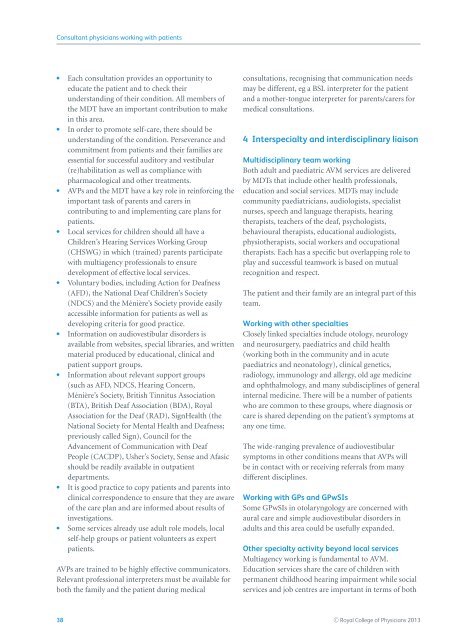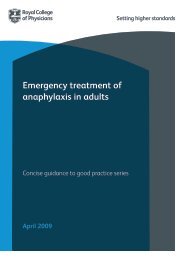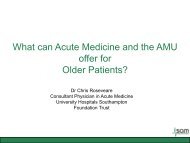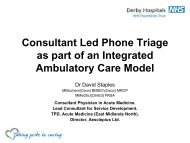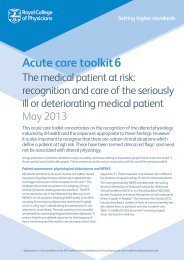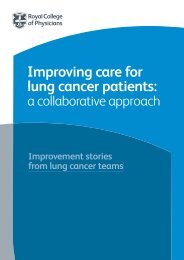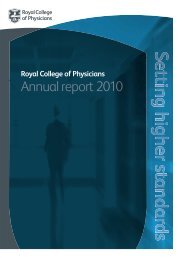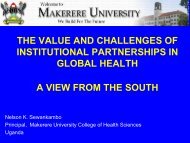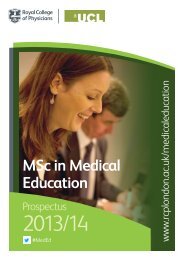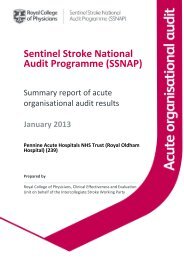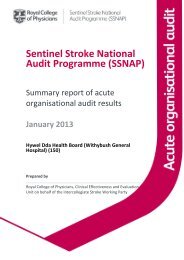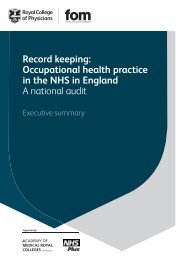Consultant physicians working with patients - Royal College of ...
Consultant physicians working with patients - Royal College of ...
Consultant physicians working with patients - Royal College of ...
You also want an ePaper? Increase the reach of your titles
YUMPU automatically turns print PDFs into web optimized ePapers that Google loves.
<strong>Consultant</strong> <strong>physicians</strong> <strong>working</strong> <strong>with</strong> <strong>patients</strong> Each consultation provides an opportunity toeducate the patient and to check theirunderstanding <strong>of</strong> their condition. All members <strong>of</strong>the MDT have an important contribution to makein this area. In order to promote self-care, there should beunderstanding <strong>of</strong> the condition. Perseverance andcommitment from <strong>patients</strong> and their families areessential for successful auditory and vestibular(re)habilitation as well as compliance <strong>with</strong>pharmacological and other treatments. AVPs and the MDT have a key role in reinforcing theimportant task <strong>of</strong> parents and carers incontributing to and implementing care plans for<strong>patients</strong>. Local services for children should all have aChildren’s Hearing Services Working Group(CHSWG) in which (trained) parents participate<strong>with</strong> multiagency pr<strong>of</strong>essionals to ensuredevelopment <strong>of</strong> effective local services. Voluntary bodies, including Action for Deafness(AFD), the National Deaf Children’s Society(NDCS) and the Ménière’s Society provide easilyaccessible information for <strong>patients</strong> as well asdeveloping criteria for good practice. Information on audiovestibular disorders isavailable from websites, special libraries, and writtenmaterial produced by educational, clinical andpatient support groups. Information about relevant support groups(such as AFD, NDCS, Hearing Concern,Ménière’s Society, British Tinnitus Association(BTA), British Deaf Association (BDA), <strong>Royal</strong>Association for the Deaf (RAD), SignHealth (theNational Society for Mental Health and Deafness;previously called Sign), Council for theAdvancement <strong>of</strong> Communication <strong>with</strong> DeafPeople (CACDP), Usher’s Society, Sense and Afasicshould be readily available in outpatientdepartments. It is good practice to copy <strong>patients</strong> and parents intoclinical correspondence to ensure that they are aware<strong>of</strong>thecareplanandareinformedaboutresults<strong>of</strong>investigations. Some services already use adult role models, localself-help groups or patient volunteers as expert<strong>patients</strong>.AVPs are trained to be highly effective communicators.Relevant pr<strong>of</strong>essional interpreters must be available forboth the family and the patient during medicalconsultations, recognising that communication needsmay be different, eg a BSL interpreter for the patientand a mother-tongue interpreter for parents/carers formedical consultations.4 Interspecialty and interdisciplinary liaisonMultidisciplinary team <strong>working</strong>Both adult and paediatric AVM services are deliveredby MDTs that include other health pr<strong>of</strong>essionals,education and social services. MDTs may includecommunity paediatricians, audiologists, specialistnurses, speech and language therapists, hearingtherapists, teachers <strong>of</strong> the deaf, psychologists,behavioural therapists, educational audiologists,physiotherapists, social workers and occupationaltherapists. Each has a specific but overlapping role toplay and successful teamwork is based on mutualrecognition and respect.The patient and their family are an integral part <strong>of</strong> thisteam.Working <strong>with</strong> other specialtiesClosely linked specialties include otology, neurologyand neurosurgery, paediatrics and child health(<strong>working</strong> both in the community and in acutepaediatrics and neonatology), clinical genetics,radiology, immunology and allergy, old age medicineand ophthalmology, and many subdisciplines <strong>of</strong> generalinternal medicine. There will be a number <strong>of</strong> <strong>patients</strong>who are common to these groups, where diagnosis orcare is shared depending on the patient’s symptoms atany one time.The wide-ranging prevalence <strong>of</strong> audiovestibularsymptoms in other conditions means that AVPs willbe in contact <strong>with</strong> or receiving referrals from manydifferent disciplines.Working <strong>with</strong> GPs and GPwSIsSome GPwSIs in otolaryngology are concerned <strong>with</strong>aural care and simple audiovestibular disorders inadults and this area could be usefully expanded.Other specialty activity beyond local servicesMultiagency <strong>working</strong> is fundamental to AVM.Education services share the care <strong>of</strong> children <strong>with</strong>permanent childhood hearing impairment while socialservices and job centres are important in terms <strong>of</strong> both38 C○ <strong>Royal</strong> <strong>College</strong> <strong>of</strong> Physicians 2013


